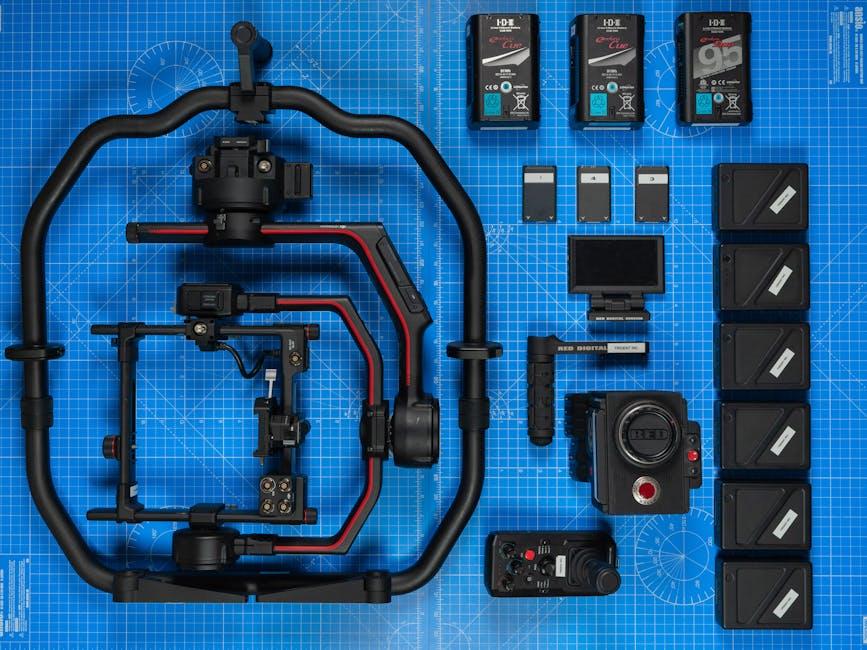In the quiet moments when your car rests, its heart—the battery—awaits a proper sanctuary to keep it alive and well. Storing a car battery might seem straightforward, but subtle details can make all the difference between a sluggish start and a smooth ignition when the time comes. Whether you’re putting a vehicle into long-term hibernation or simply keeping a spare battery on hand, understanding the art and science of battery storage ensures longevity and performance. Let’s dive into the essential steps for preserving your car battery’s life, so it’s always ready to power your journey ahead.
Table of Contents
- Choosing the Ideal Location for Long-Term Battery Storage
- Preparing the Battery for Storage With Thorough Cleaning
- Maintaining Optimal Charge Levels During Dormancy
- Controlling Temperature and Humidity to Extend Battery Life
- Regular Inspection and Maintenance While Stored
- Safe Handling and Reinstallation Tips After Storage
- Q&A
- Future Outlook

Choosing the Ideal Location for Long-Term Battery Storage
When selecting a spot for long-term battery storage, it’s crucial to focus on environmental stability. A location that maintains a consistent temperature, ideally between 32°F and 77°F (0°C to 25°C), helps prevent the battery from freezing or overheating, which can drastically reduce its lifespan. Additionally, the area should be dry and well-ventilated to avoid moisture buildup, which might lead to corrosion or acid leaks. Avoid direct sunlight or places with rapid temperature fluctuations to maintain the battery’s optimal condition.
Besides temperature and ventilation, consider safety and accessibility. Store the battery away from flammable materials and ensure it’s kept on a surface that won’t conduct electricity, like wood or a specialized battery tray. Here’s a quick checklist to guide your choice:
- Stable temperature environment (no freezing or excessive heat)
- Dry and moisture-free air circulation
- Non-conductive surface for placement
- Safe distance from flammables and direct sunlight
- Easy access for periodic checks and maintenance
| Factor | Ideal Condition |
|---|---|
| Temperature | 32°F – 77°F (0°C – 25°C) |
| Humidity | Low and controlled |
| Surface | Wood or battery tray |
| Proximity | Far from flammables |

Preparing the Battery for Storage With Thorough Cleaning
Before tucking your car battery away for an extended period, giving it a meticulous clean is essential to prevent corrosion and maintain optimal performance. Begin by disconnecting the battery cables—always removing the negative cable first—and place the battery on a clean, dry surface. Use a mixture of baking soda and water to scrub the terminals gently with a soft brush, neutralizing any acidic residue. Rinse lightly with water and dry thoroughly to ensure no moisture lingers, which could contribute to corrosion during storage.
Cleaning doesn’t stop at the terminals. Wipe down the entire battery case with a damp cloth to remove dirt and grease, which can accelerate deterioration. For added protection, apply a thin coat of petroleum jelly or a specialized battery terminal protector to the posts—this creates a shield against oxidation. Here’s a quick checklist to keep handy during your cleaning process:
- Disconnect cables properly (negative first)
- Use baking soda paste for neutralizing acid
- Rinse and dry the battery thoroughly
- Wipe the case to remove grime
- Apply protective coating on terminals

Maintaining Optimal Charge Levels During Dormancy
Keeping your car battery in good shape during periods of inactivity requires more than just disconnecting it from your vehicle. It’s essential to prevent the charge from dropping below a critical level, which can cause irreversible damage. To avoid this, consider using a trickle charger or battery maintainer—devices designed to supply a low, steady current to keep the battery fully charged without overcharging. This approach ensures that when it’s time to hit the road again, your battery will be ready to perform at its best.
Here are some practical tips to help maintain the battery’s charge:
- Store the battery in a cool, dry environment to slow down natural self-discharge.
- Check the battery voltage weekly with a voltmeter to track its charge status.
- Remove the battery from the vehicle if the car will be dormant for more than a month to prevent drain from electronic components.
| Action | Recommended Frequency | Benefit |
|---|---|---|
| Voltage Check | Weekly | Prevents deep discharge |
| Trickle Charging | Continuous | Maintains optimal charge level |
| Storage Environment | Always | Reduces self-discharge rate |

Controlling Temperature and Humidity to Extend Battery Life
Maintaining an ideal environment is crucial for preserving your car battery’s longevity. Batteries are highly sensitive to temperature extremes; excessive heat accelerates chemical reactions inside, causing faster degradation, while freezing temperatures can reduce a battery’s capacity temporarily or even cause permanent damage. To avoid these pitfalls, keep your battery stored in a climate-controlled space with steady, moderate temperatures, ideally between 32°F (0°C) and 77°F (25°C). This balance protects internal components and minimizes self-discharge.
Humidity control is equally important, as excessive moisture promotes corrosion on battery terminals and internal parts, which can drastically reduce performance. Using a dehumidifier or placing silica gel packets nearby helps maintain a dry environment. Consider these key points when managing storage conditions:
- Temperature Range: Avoid locations with drastic temperature fluctuations
- Humidity Level: Keep relative humidity below 60%
- Ventilation: Ensure proper airflow to reduce moisture buildup
| Environment Factor | Optimal Range | Impact on Battery |
|---|---|---|
| Temperature | 32°F – 77°F (0°C – 25°C) | Prevents acceleration of degradation |
| Humidity | Below 60% RH | Reduces corrosion risk |

Regular Inspection and Maintenance While Stored
Keeping a stored car battery in pristine condition demands consistent vigilance. Even while inactive, batteries can slowly discharge or develop sulfation on the plates, reducing their lifespan. It’s vital to check on the battery every few weeks, ensuring the voltage remains above 12.4 volts for an optimal charge. Use a digital voltmeter for precise readings, and if you notice any significant drop, consider charging it with a smart charger to prevent permanent damage.
Alongside voltage checks, physical inspections are equally important. Look for any signs of corrosion around the terminals, which can be wiped clean with a solution of baking soda and water. Keep the battery stored in a cool, dry place away from direct sunlight or extreme temperatures, as excessive heat or cold can accelerate deterioration. Below is a simple maintenance checklist to ensure your battery stays healthy while on the shelf:
- Voltage Monitoring: Measure every 2-3 weeks
- Charge Maintenance: Use a trickle or smart charger if voltage drops
- Terminal Cleaning: Remove corrosion buildup as needed
- Proper Environment: Store in a temperature-controlled, dry area
- Physical Check: Look for cracks, leaks, or swelling

Safe Handling and Reinstallation Tips After Storage
Before reinstalling your stored car battery, conduct a thorough inspection. Look for any signs of corrosion, cracks, or leaks. A simple wipe with a mixture of baking soda and water can neutralize acidic buildups around the terminals, ensuring a better electrical connection. Always wear insulated gloves and eye protection to minimize the risk of acid exposure or electrical shock. When reconnecting, attach the positive terminal first, followed by the negative to reduce the risk of short circuits.
To maximize battery life post-storage, consider these quick tips:
- Fully charge the battery before installation to jump-start its performance.
- Check the electrolyte levels if applicable, topping off with distilled water as needed.
- Securely mount your battery to prevent vibrations that could damage internal plates.
- Perform a voltage test after installation to ensure the battery is operating within optimal parameters.
| Step | Action | Reason |
|---|---|---|
| 1 | Inspect and clean terminals | Ensures proper electrical contact |
| 2 | Charge fully before use | Restores full capacity |
| 3 | Check electrolyte levels | Prevents damage from drying out |
| 4 | Secure and voltage test | Guarantees safe and efficient operation |
Q&A
Q&A: How to Store a Car Battery Properly
Q1: Why is proper storage important for a car battery?
A1: Proper storage preserves the battery’s charge and lifespan. Without correct care, batteries can lose power, suffer internal damage, or even leak harmful chemicals, making them unsafe and costly to replace.
Q2: When should I consider storing my car battery?
A2: Storing a battery is useful during long periods of inactivity—like when you store a classic car for winter or keep a spare battery for emergencies. It ensures the battery stays healthy until you need it again.
Q3: What’s the first step before storing a car battery?
A3: Clean the battery thoroughly. Remove dirt, corrosion, and grease from the terminals with a mixture of baking soda and water. This prevents discharge and corrosion during storage.
Q4: Should I disconnect the battery from the vehicle?
A4: Yes. Always disconnect the battery terminals to avoid parasitic drain from electronics and to ensure safety while handling or storing it.
Q5: Where’s the ideal place to store a car battery?
A5: Store it in a cool, dry, and well-ventilated area. Avoid places with extreme temperatures or humidity, like garages without insulation or outdoors exposed to elements, since these conditions can degrade the battery.
Q6: Is it necessary to keep the battery charged while in storage?
A6: Absolutely. Batteries self-discharge over time, so use a trickle charger or battery maintainer designed for long-term storage to keep it topped up without overcharging.
Q7: How often should I check on a stored battery?
A7: Inspect and recharge the battery every 4 to 6 weeks. This prevents deep discharge, which can permanently damage the battery’s cells.
Q8: Can a car battery freeze during storage?
A8: Yes, if the battery is not fully charged, it’s at risk of freezing in cold conditions. A fully charged battery has antifreeze properties that protect it from freezing, making proper charging essential.
Q9: Are there any safety precautions I should take when storing batteries?
A9: Always store batteries upright on a protective, non-conductive surface. Keep them away from flammable materials, and handle with gloves and eye protection to guard against acid leaks.
Q10: What signs indicate a stored battery is no longer good?
A10: Look for bulging, cracks, leaks, or a foul odor. If the battery doesn’t hold a charge after maintenance or shows physical damage, it’s time for a replacement.
By following these steps, your car battery will stay in prime condition, ready to power your vehicle whenever you are.
Future Outlook
Properly storing your car battery might seem like a simple task, but it’s a vital step in ensuring long-lasting performance and reliability. By following the right practices—keeping it clean, cool, and charged—you’re not just preserving a piece of equipment; you’re safeguarding the power that gets you moving. Whether you’re tucking your vehicle away for the winter or simply giving its battery a well-earned break, a little care goes a long way. So, treat your battery well, and it will reciprocate by staying ready to roar back to life whenever the road calls.

